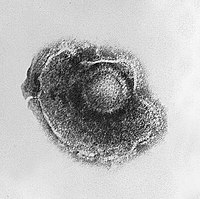
Photo from wikipedia
Varicella zoster virus (VZV) and simian varicella virus (SVV) cause varicella (chickenpox) in children and nonhuman primates, respectively. After resolution of acute disease, the viruses establish latent infection in neural… Click to show full abstract
Varicella zoster virus (VZV) and simian varicella virus (SVV) cause varicella (chickenpox) in children and nonhuman primates, respectively. After resolution of acute disease, the viruses establish latent infection in neural ganglia, after which they may reactivate to cause a secondary disease, such as herpes zoster. SVV infection of nonhuman primates provides a model to investigate VZV pathogenesis and antiviral strategies. The VZV and SVV genomes are similar in size and structure and share 70–75% DNA homology. SVV and VZV DNAs are co-linear in gene arrangement with the exception of the left end of the viral genomes. Viral gene expression is regulated into immediate early, early, and late transcription during in vitro and in vivo infection. During viral latency, VZV and SVV gene expression is limited to transcription of a viral latency-associated transcript (VLT). VZV and SVV are closely related alphaherpesviruses that likely arose from an ancestral varicella virus that evolved through cospeciation into species-specific viruses.
Journal Title: Viruses
Year Published: 2022
Link to full text (if available)
Share on Social Media: Sign Up to like & get
recommendations!